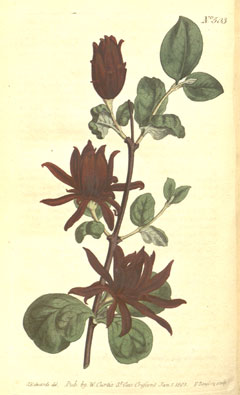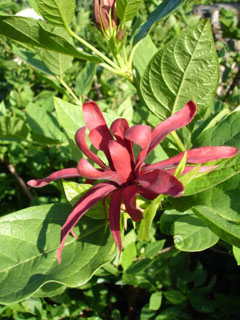 |
|
http://commons.wikimedia.org/wiki/File:The_Botanical_Magazine,_Plate_503_(Volume_14,_1800).png |
 |
| http://commons.wikimedia.org/wiki/User:Epibase |
Translate this page:
Summary
Bloom Color: Red.
Main Bloom Time: Early summer, Early spring, Late summer, Late spring, Mid summer, Mid spring. Form: Oval, Rounded.
Physical Characteristics

 Calycanthus floridus is a deciduous Shrub growing to 2.7 m (8ft) by 2 m (6ft) at a medium rate.
Calycanthus floridus is a deciduous Shrub growing to 2.7 m (8ft) by 2 m (6ft) at a medium rate.
See above for USDA hardiness. It is hardy to UK zone 5 and is not frost tender. It is in flower from June to July, and the seeds ripen from October to November. The species is hermaphrodite (has both male and female organs) and is pollinated by Insects.
Suitable for: light (sandy) and medium (loamy) soils and prefers well-drained soil. Suitable pH: mildly acid, neutral and basic (mildly alkaline) soils. It can grow in semi-shade (light woodland) or no shade. It prefers moist soil.
UK Hardiness Map
US Hardiness Map
Synonyms
C. sterilis.
Plant Habitats
Woodland Garden Sunny Edge; Dappled Shade;
Edible Uses
Edible Parts:
Edible Uses: Condiment
The aromatic bark is dried and used as a substitute for cinnamon[2, 11, 46, 61, 105, 161, 183]. Some caution is advised, see reports above on toxicity[270].
References More on Edible Uses
Medicinal Uses
Plants For A Future can not take any responsibility for any adverse effects from the use of plants. Always seek advice from a professional before using a plant medicinally.
Antiperiodic Antispasmodic Cardiac Disinfectant Diuretic Emetic Ophthalmic Skin
Antispasmodic, disinfectant[106, 169]. The plant contains an alkaloid that has a powerfully depressant action on the heart[4]. A fluid extract has been used as an antiperiodic[4]. A tea made from the root or bark has been used as a strong emetic and diuretic for kidney and bladder ailments[222, 257]. A cold tea has been used as eye drops in the treatment of failing eyesight[222, 257]. An ooze from the bark has been used to treat children's sores, whilst an infusion has been used to treat hives[257].
References More on Medicinal Uses
The Bookshop: Edible Plant Books
Our Latest books on Perennial Plants For Food Forests and Permaculture Gardens in paperback or digital formats.

Edible Tropical Plants
Food Forest Plants for Hotter Conditions: 250+ Plants For Tropical Food Forests & Permaculture Gardens.
More

Edible Temperate Plants
Plants for Your Food Forest: 500 Plants for Temperate Food Forests & Permaculture Gardens.
More

More Books
PFAF have eight books available in paperback and digital formats. Browse the shop for more information.
Shop Now
Other Uses
References More on Other Uses
Cultivation details
Landscape Uses:Border, Pest tolerant, Screen, Specimen. Prefers a light loamy soil that is deep and moist but succeeds in most fertile soils[11, 182]. Requires a well-drained soil[188]. Prefers a sunny position but it tolerates shade when grown in warm temperate zones[11, 200]. Requires a sheltered position, protected from cold winds[245]. Although the dormant plant is hardy to at least -20°c, the tender young growth in the spring can be damaged by late frosts[K]. All parts of the plant are richly fragrant[182]. The flowers have a refreshing scent of ripe apples[245]. The wood, leaves and roots smell strongly of camphor, whilst the bark smells like cinnamon[245]. This species is closely related to C. mohrii[182]. A very ornamental plant, there is at least one named variety developed for its ornamental value. 'Mrs Henry Type' is a large-flowered form[182]. Plants in this genus are notably resistant to honey fungus[200]. Special Features:
North American native, Fragrant foliage, All or parts of this plant are poisonous, Wetlands plant, Fragrant flowers, Attractive flowers or blooms. The plant is heat tolerant in zones 9 through 1. (Plant Hardiness Zones show how well plants withstand cold winter temperatures.
Plant Heat Zones show when plants would start suffering from the heat.
The Plant Heat Zone map is based on the number of "heat days" experienced in a given area where the temperature climbs to over 86 degrees F (30°C).
At this temperature, many plants begin to suffer physiological damage. Heat Zones range from 1 (no heat days) to 12 (210 or more heat days).
For example Heat Zone. 11-1 indicates that the plant is heat tolerant in zones 11 through 1.) For polyculture design as well as the above-ground architecture (form - tree, shrub etc. and size shown above) information on the habit and root pattern is also useful and given here if available. A clumping plant, forming a colony from shoots away from the crown but with a limited spread [1-2]. The root pattern is flat with shallow roots forming a plate near the soil surface [1-2]. The root pattern is suckering with new plants from underground runners away from the plant [1-2].
References Carbon Farming Information and Carbon Sequestration Information
Temperature Converter
Type a value in the Celsius field to convert the value to Fahrenheit:
Fahrenheit:
The PFAF Bookshop
Plants For A Future have a number of books available in paperback and digital form. Book titles include Edible Plants, Edible Perennials, Edible Trees,Edible Shrubs, Woodland Gardening, and Temperate Food Forest Plants. Our new book is Food Forest Plants For Hotter Conditions (Tropical and Sub-Tropical).
Shop Now
Plant Propagation
Seed - best sown in a cold frame as soon as it is ripe. If the seed is harvested 'green' (as soon as it has fully developed but before it has dried on the plant) and sown immediately it can germinate in 3 weeks[113]. Dried seed germinates in 1 - 6 months at 15°c[138]. Stored seed requires between 3 weeks and 3 months cold stratification before sowing in the spring. When large enough to handle, prick out the seedlings into individual pots and grow them on in the greenhouse for their first winter. Plant out in late spring or early summer of the following year. Cuttings of half-ripe wood, July/August in a frame. They can be difficult[113]. Layering in spring. Sever the new plants in a wet spell of weather about 15 months later and then lift them in the autumn[78]. High percentage[78]. Division of suckers in early spring[11]. Very easy, they can be planted straight out into their permanent positions if required.
Other Names
If available other names are mentioned here
Native Range
NORTHERN AMERICA: United States, Ohio (south), Pennsylvania (south), West Virginia, Alabama, Florida (northwest), Georgia, Kentucky (east), Maryland, Mississippi, North Carolina, South Carolina, Tennessee, Virginia,
Weed Potential
Right plant wrong place. We are currently updating this section.
Please note that a plant may be invasive in one area but may not in your area so it's worth checking.
Conservation Status
IUCN Red List of Threatened Plants Status :

Growth: S = slow M = medium F = fast. Soil: L = light (sandy) M = medium H = heavy (clay). pH: A = acid N = neutral B = basic (alkaline). Shade: F = full shade S = semi-shade N = no shade. Moisture: D = dry M = Moist We = wet Wa = water.
Now available:
Food Forest Plants for Mediterranean Conditions
350+ Perennial Plants For Mediterranean and Drier Food Forests and Permaculture Gardens.
[Paperback and eBook]
This is the third in Plants For A Future's series of plant guides for food forests tailored to
specific climate zones. Following volumes on temperate and tropical ecosystems, this book focuses
on species suited to Mediterranean conditions—regions with hot, dry summers and cool, wet winters,
often facing the added challenge of climate change.
Read More
Expert comment
Author
L.
Botanical References
11200270
Links / References
For a list of references used on this page please go here
Readers comment